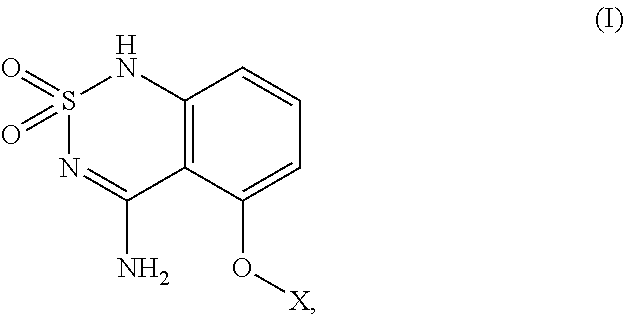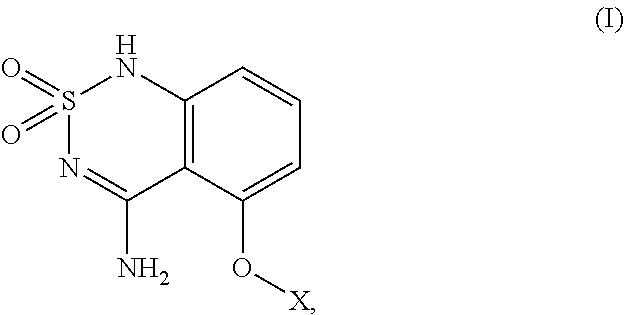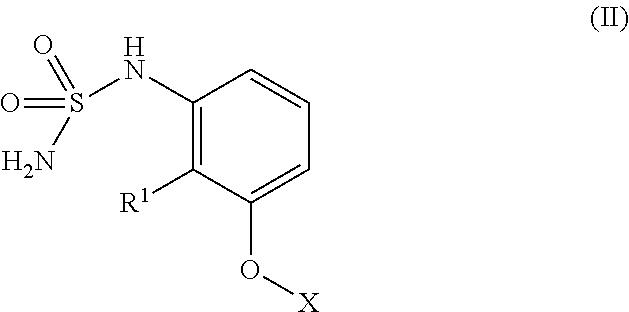Processes and intermediates for making sweet taste enhancers
a technology of sweet taste and enhancer, which is applied in the preparation of carboxylic acid nitrile, carboxylic acid amides, organic chemistry, etc., can solve the problems of delayed onset and lingering sweetness of sweeteners such as sucralose and aspartame, and the reported sweetness delivery problems of high intensity sweeteners
- Summary
- Abstract
- Description
- Claims
- Application Information
AI Technical Summary
Benefits of technology
Problems solved by technology
Method used
Image
Examples
specific embodiments
[0143]The following examples and schemes are provided to illustrate the processes / methods and intermediates for preparing compounds of the present invention.
[0144]In one embodiment of the present invention, the compound having structural formula (I) or formula (Ia) is compound 9 below:
[0145]
[0146]One approach to the synthesis of 9 (scheme 1) requires 4 steps starting from commercially available 3-hydroxy-2,2-dimethylpropanoic acid (1). The acid 1 is first coupled to the amine 2 using conventional coupling reaction to provide the amide 3 that is further reacted with 2-amino-6-fluorobenzonitrile 4 (Chimia 2006, 60, 584) to give the 2-amino nitrile derivative 5. Treatment of 5 with sulfamoyl chloride 7, prepared from chlorosulfonyl isocyanate 6 (Brodsky, B. H.; Bois, J. D. J. Am. Chem. Soc. 2005, 127, 15391.), provides the sulfamoylamino derivative 8 that is further cyclized to 9 in the presence of NaOH.
[0147]
[0148]In one embodiment of Scheme 1, different bases were evaluated for the c...
example 1
Synthesis of Compound 3
[0209]To a 5-Gal pressure reactor was charged methyl 3-hydroxy-2,2-dimethylpropanoate 10 (4.5 kg, 34.05 mol, 1 equiv.) and n-propylamine 2 (3.02 kg, 4.2 L, 51.07 mol, 1.5 equiv.) and the mixture stirred and heated to 120° C. The pressure of the reactor rose to 54 psig and the temperature of the reactor was maintained by the use of a heating jacket and internal cooling coils that contained glycol. This setup did cause the internal pressure to fluctuate over a range of 30 psig to 54 psig due to the cooling and heating of the vapor phase of the reactor. The reaction was monitored by GC and after 93 h the residual methyl 3-hydroxy-2,2-dimethylpropanoate 1 was 1.95% (AUC) by GC relative to compound 3. The contents of the reactor were then allowed to cool to ambient temperature and the batch was transferred to a suitable container and concentrated on a 20-L rotary evaporator using toluene to azeotropically remove residual methanol along with the low boiling n-propyl...
example 2
Synthesis of Compound 5
[0212]To a dried 750-L reactor purged with nitrogen was charged NaH (60% dispersion in mineral oil, 3.6 kg, 90.0 mol, 1.7 equiv.) and low water THF (160 L) and the resulting slurry was cooled to 0-10° C. Compound 3 (9.07 kg (theoretical based on wt % calculation of solutions), 57 mol, 1.08 equiv. in anhydrous THF) was then further diluted with low water THF (71 L) and charged portionwise to the NaH / THF slurry maintaining the reaction temperature at 0-10° C. Once the addition was complete the reactor was warmed to 20-25° C. and held at this temperature for at least 30 min. To this was slowly charged a solution of 2-amino-6-fluorobenzonitrile (7.2 kg, 52.9 mol, 1 equiv.) 4 in low water THF (35.5 L) over a period of at least 30 min., maintaining the reaction temperature at 20-30° C. Once the addition was complete the reaction mixture was heated to reflux and after 10 h the residual 2-amino-6-fluorobenzonitrile was 1.7% (AUC) by GC relative to Compound 5. The batc...
PUM
| Property | Measurement | Unit |
|---|---|---|
| temperature | aaaaa | aaaaa |
| temperature | aaaaa | aaaaa |
| temperature | aaaaa | aaaaa |
Abstract
Description
Claims
Application Information
 Login to View More
Login to View More - R&D
- Intellectual Property
- Life Sciences
- Materials
- Tech Scout
- Unparalleled Data Quality
- Higher Quality Content
- 60% Fewer Hallucinations
Browse by: Latest US Patents, China's latest patents, Technical Efficacy Thesaurus, Application Domain, Technology Topic, Popular Technical Reports.
© 2025 PatSnap. All rights reserved.Legal|Privacy policy|Modern Slavery Act Transparency Statement|Sitemap|About US| Contact US: help@patsnap.com



